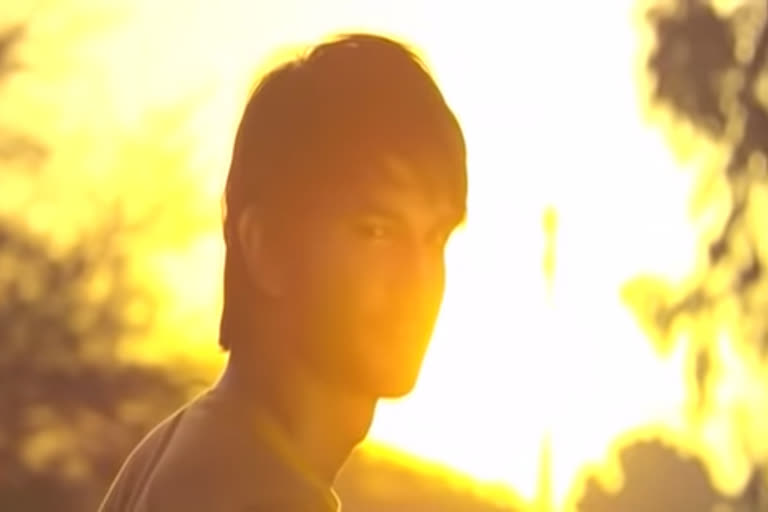Hyderabad: One way of looking at Sushant Singh Rajput's life may well be that it was a chronicle of a death foretold. Take a look at his display picture on Twitter, The Starry Night, painted by Vincent Van Gogh in 1889, a year after his breakdown that resulted in the self mutilation of his ear. Or his last Instagram post, from June 3, with a picture of his beloved mother who passed away in 2002, with the words: Blurred past evaporating from teardrops/ Unending dreams carving an arc of a smile/ And a fleeting life/ negotiating between the two.
Not everyone has a bucket list at the age of 34, but Sushant, who died by suicide this week, did. As if that was not enough, he also died on screen in five of the eleven films he did since his stunning movie debut in Kai Po Che! in 2013. As the charismatic Ishaan, the abiding image from the film is of the backlit Sushant walking into the sunset, happy that his protege Ali Hashmi has made a smashing debut playing for India against Australia. Ishaan's death was a conscious decision director Abhishek Kapoor took and it was a change from the book it was based on, Chetan Bhagat's The 3 Mistakes of My Life. It was Kapoor's way of distilling the pain and savagery of the Godhra train massacre and the Gujarat riots into one act, the deliberate death of the film's most loved character.
In Raabta (2017), the reincarnation drama directed by Dinesh Vijan, one of his avatars dies, the other, Shiv Kakkar, is saved from drowning by the girl. In Kedarnath (2018), set against the backdrop of the 2013 floods in Uttarakhand, he plays a Muslim guide who falls in love with the temple priest's daughter and it is to save her, among others, that he foregoes his place in the departing helicopter. The last scene, his arms outstretched, like his favourite actor, Shah Rukh Khan, before he turns and is swallowed up by the earth is difficult to watch now given the reality of his death.
Read: Twin Talents
In Sonchiriya (2019), the dacoit film shot by Abhishek Chaubey, his character Lakhna invites a heroic death from the arch rival played by Ashutosh Rana, choosing quite deliberately to step out from his hideout behind a tree. In an interview after his death, Chaubey said, "That moment in the film where Lakhna has a vision of his alternate life, has taken a completely different meaning in my head. It has taken a life of its own."
In his last theatrical release, Chichhore, his cinematic son narrowly avoids death, sparking the video that has now gone viral, of Sushant as the father telling the son: "Tumhara result nahin decide karta ki tum loser hain ki nahin, tumhari koshish decide karti hai (Your result doesn't decide whether you're a loser, your effort does)." Words to live by.
And those who hope for a happy ending in the last film he shot will be disappointed again. As an official remake of 'The Fault in Our Stars', Dil Bechara, which is slated for a release on streaming, can only end one way, though both the boy and girl in it are suffering from cancer -- the surprising death of the boy though it is the girl who seems critically ill through most of the film.
Read: When cinemas open, movie-going will change
Cinematic deaths are a powerful way of bonding with audiences. The careers of both Shah Rukh Khan and Amitabh Bachchan are proof of it. According to one estimate, Shah Rukh Khan has died onscreen in 17 of his movies, while Bachchan has met his maker 27 times in film. Both are beloved as are some of their death scenes, from Amitabh Bachchan's last breaths in his mother's lap in Deewar (1975) to Khan's dramatic designer death in Devdas (2002), with Aishwarya Rai's Paro rushing towards the gates of the haveli as they close in on her, her saree pallu streaming behind her.
Read: When it comes to pandemics, reel life is ahead of reality
Sushant Singh Rajput was a bright man, who could quote astrophysicists as easily as he could quote Swami Vivekananda. He knew all about suffering and struggle, having begun as a back-up dancer in Shiamak Davar's troupe. As he tweeted in October 2019, "The West says, we minimise evil by conquering it. India says, we destroy evil by suffering, until evil is nothing but positive enjoyment, The goal is the same, however opposite it may appear. As we wend our way through his mazy vale of life, let us bid each other Godspeed."
Equally he was aware of the impermanence of fame and life. "Like the shadow I am and I am not," he tweeted in December 2018, quoting Rumi, foreshadowing the time perhaps when he would find his way back from the spotlight, the abandoned films, broken promises, and lost opportunities behind him forever.
(Kaveree Bamzai, a recipient of the Chevening Scholarship, has formerly worked with The Times of India and The Indian Express and has been the editor of India Today. She is also a member of the CII National Committee for Women's Empowerment and Committee on Media and Entertainment)



